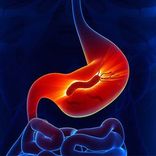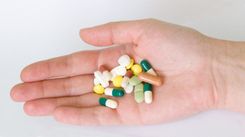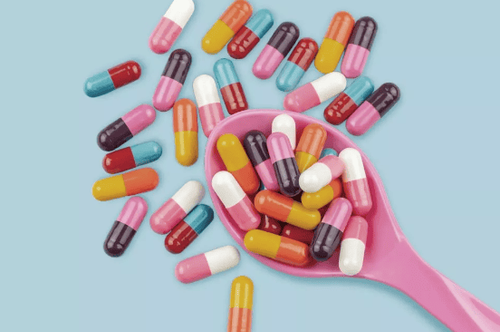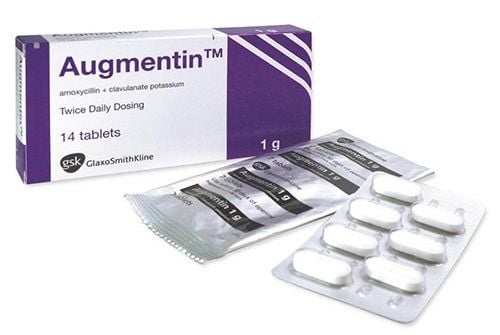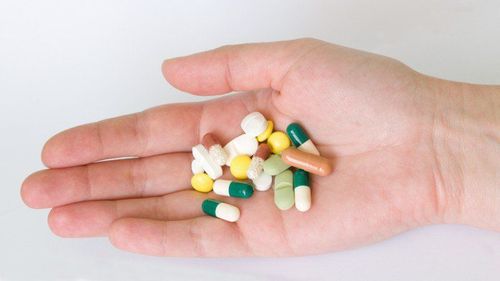Currently, the development of active ingredients to treat HIV infection creates the expectation of long-term survival for patients. In addition, the current trend is to use products that combine many active ingredients such as Agriptera. So what is Agriptera and how is it used?
1. What is Acriptega?
Acriptega contains 3 active ingredients: Dolutegravir, Lamivudine, Tenofovir with the following content:
Dolutegravir: 50mg;
Lamivudine: 300mg;
Tenofovir disoproxil: 300mg.
The active ingredient Lamivudine in Agriptera is rapidly absorbed after oral administration with a bioavailability of about 80 - 85%. Lamivudine is excreted mainly unchanged through the kidneys and the half-life ranges from 5 to 7 hours.
Tenofovir disoproxil fumarate is rapidly absorbed and then converted to Tenofovir. The bioavailability is about 25% when taken on an empty stomach, increasing when taken with a high-fat meal. Tenofovir in Agriptera is eliminated mainly by the kidneys, both by glomerular filtration and the renal tubular transport system with approximately 70 - 80% of the dose excreted unchanged in the urine.
Dolutegravir is rapidly absorbed after oral administration, with a mean Tmax of approximately 2-3 hours. Food increases the extent but slows the rate of absorption of Dolutegravir. Therefore, Agriptera is recommended to be taken with food in patients with integrase-resistant HIV. The drug is metabolized by glucuronide conjugation and to a small extent by the CYP3A4 system. Renal excretion of unchanged Dolutegravir is very low (<1% of the dose), the majority (approximately 53% of the oral dose) is excreted unchanged in the feces.
2. Uses of Acriptega
Acriptega is indicated in the following cases:
Treatment of HIV-1 infection in adults and adolescents (12 years of age and older and weighing over 40 kg) with the ability to suppress the virus to HIV1 RNA concentration < 50 copies/ml according to the current antiretroviral combination regimen for at least 3 months;
Patients with no virological failure on previous antiretroviral regimens.
Lamivudine is a dideoxynucleoside analogue and Tenofovir disoproxil fumarate is metabolized into Tenofovir after entering the body, which is a Nucleoside Monophosphate analogue. Lamivudine and Tenofovir are phosphorylated through cellular enzymes to form Lamivudine triphosphate and tenofovir diphosphate. These two active ingredients competitively inhibit the reverse transcription process of the HIV-1 virus, thereby terminating DNA. Therefore, the 2 active ingredients in Agriptera have the effect of fighting HIV1 and HIV2 viruses, in addition to the ability to fight against hepatitis B virus.
The remaining active ingredient in Agriptera is Dolutegravir, which inhibits HIV integrase through the mechanism of binding to the Integrase active site and inhibiting the transition step of the integration process of retroviral Deoxyribonucleic acid (DNA).
3. How to use Acriptega?
Acriptega should be prescribed by a physician experienced in the treatment of HIV-1 infection. When used, the patient should swallow the Agriptera tablet whole with enough water.
Acriptega dosage:
- Adults and adolescents (from 12 years old, weight ≥ 40 kg): The recommended dose is 1 Agriptera 50/300/300 tablet, once daily;
- Acriptega is not recommended for use in patients weighing less than 40 kg because Agriptera is formulated as a fixed-dose combination tablet, so the dose cannot be reduced;
- Acriptera is a fixed-dose combination tablet, so it is not suitable for people with HIV who need to adjust the dose. The single-agent preparations of Lamivudine, Tenofovir disoproxil fumarate and Dolutegravir are now available and would be more suitable for use in cases where it is necessary to stop or adjust the dose of one of the active ingredients of Agriptera.
4. What are the side effects of Acriptega?
During the use of Agriptera, patients may experience some unwanted side effects (ADR). In which, very common ADRs include:
- Hematological disorders such as decreased neutrophil count, anemia (sometimes very severe) or thrombocytopenia;
- Decreased blood phosphate concentration;
- Dizziness, headache and insomnia;
- Cough or nasal symptoms;
- Digestive disorders such as diarrhea, nausea, vomiting, abdominal pain, flatulence;
- Skin rash or hair loss;
- Joint pain or muscle dysfunction;
- Systemic manifestations such as fatigue, discomfort, fever.
Some rare side effects of Agriptera:
- Pure red blood cell aplasia;
- Lactic acidosis;
- Peripheral neuropathy;
- Dyspnea;
- Pancreatitis, increased serum amylase or hepatitis;
- Acute renal failure, proximal renal tubular disease, increased serum creatinine or acute tubular necrosis.
5. Contraindications of Agriptega
Acriptega should not be used in the following cases:
People with a history of allergy to Tenofovir, Lamivudine, Dolutegravir and excipients in Agriptera tablets;
Contraindicated when used in combination with Dofetilide.
6. Some precautions when using Agriptega
Acriptega tablets should not be used at the same time as products containing the active ingredients Dolutegravir, Lamivudine, Tenofovir disoproxil fumarate or Cytidine analogues (such as emtricitabine and adefovir dipivoxil);
Possibility of HIV transmission: Treatment with Agriptera does not completely eliminate the possibility of transmitting HIV to others through sexual contact or blood, although the risk may be reduced. Therefore, people with HIV must continue to use appropriate measures to prevent HIV transmission;
The safety of the active ingredient Dolutegravir has not been studied in patients with severe liver disease. Therefore, Acriptega should only be used in patients with liver disease when the treatment benefits outweigh the health risks, and close monitoring is required to ensure safety;
HIV patients co-infected with hepatitis B or hepatitis C virus should be aware that people with chronic hepatitis B or C when treated with combination antiretroviral regimens are at increased risk of serious adverse liver effects, even death;
Hypersensitivity reactions associated with Dolutegravir in Agriptera have been reported, characterized by rash and occasionally organ dysfunction;
Renal function: Tenofovir is mostly eliminated by the kidneys through a combination of glomerular filtration and tubular secretion. Therefore, the clearance of Agriptera may be impaired in patients with impaired renal function;
Lactic acidosis is a rare but potentially life-threatening complication associated with Nucleoside Reverse Transcriptase Inhibitors (nNRTIs);
Pancreatitis: Treatment with Acriptega should be discontinued immediately if clinical symptoms or blood test results suggestive of pancreatitis appear;
Opportunistic infections: People taking antiretroviral drugs such as Agriptera are at increased risk of developing opportunistic infections or other complications of HIV infection.
Some precautions for Agriptera in pregnant women:
- Some studies conducted in animals have not shown direct or indirect effects of Tenofovir disoproxil fumarate on maternal health, fetal development, labor or postnatal development. In humans, the safety of Tenofovir in pregnancy has not been fully studied;
- There are no reports of congenital malformations in the fetus when pregnant women use Lamivudine. However, this does not completely rule out the risk of harm to the fetus from Agriptera;
- There is not much evidence of the use of Dolutegravir in pregnant women.
Therefore, the effects of this active substance on pregnancy have not been fully determined, so Dolutegravir should only be used in pregnant women when the benefits outweigh the potential risks to the fetus.
Some precautions for Agriptera in breastfeeding women:
- Animal studies have shown that Tenofovir is excreted in breast milk, but this possibility is not known in humans. Another active substance in Agriptera, Lamivudine, has been shown to be excreted in breast milk;
- It is not known whether Dolutegravir is excreted in breast milk, although animal studies have shown that this active substance is found in breast milk;
- Current recommendations are that HIV-infected women should not breastfeed under any circumstances to avoid transmitting HIV to their children.
7. Drug interactions of Agriptera
7.1. Interactions of the active ingredient Lamivudine
Concomitant use of Lamivudine with Trimethoprim/Sulfamethoxazole may increase the area under the curve of Lamivudine by 40%. However, in this case, it is not necessary to adjust the dose of Acriptega. In the opposite direction, Lamivudine does not affect the pharmacokinetics of Trimethoprim or Sulfamethoxazole.
7.2. Interactions related to Tenofovir
Didanosine: It is recommended not to use products containing Tenofovir disoproxil fumarate (such as Agriptera) and Didanosine at the same time;
Drugs eliminated by the kidney: Tenofovir is mainly eliminated by the kidney, therefore, when Tenofovir disoproxil fumarate is used concurrently with products that can cause renal impairment or compete for renal tubular secretion, it will increase the concentration of Tenofovir serum and/or the concomitantly used drug products;
Tenofovir disoproxil fumarate should be avoided concurrently with nephrotoxic drugs, such as Aminoglycoside antibiotics, Amphotericin B, Foscarnet, Ganciclovir, Pentamidine, Vancomycin, Cidofovir or interleukin-2;
Tenofovir must be taken with food because food increases the bioavailability of Tenofovir.
7.3. Interactions related to Dolutegravir
All factors that reduce the concentration of Dolutegravir should be avoided in the presence of integrase resistance;
Dolutegravir is eliminated primarily through the metabolism of UGT1A1, so drugs that induce this enzyme may decrease the plasma concentrations of Dolutegravir and reduce its therapeutic effect.
To arrange an appointment, please call HOTLINE or make your reservation directly HERE. You may also download the MyVinmec app to schedule appointments faster and manage your reservations more conveniently.

